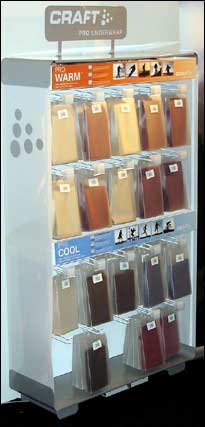Nilorn Group, a producer of clothing labels, has developed an RFID-enabled self-inventorying product display for sports apparel company Craft of Scandinavia. Craft expects to use the system to track inventory of its merchandise within retail stores. Since September, says Per Wagnås, Nilorn’s VP of retail information systems, the garment maker has been testing the system in Nilorn’s Gothenburg, Sweden, showroom using a mobile test unit.

The testing involves experimenting with various RFID interrogators, antennas, software and tags. If the tests go well, Wagnås says, Craft intends to install the system in stores throughout Sweden that carry its products. A meeting to discuss the ongoing test’s success, as well as plans to deploy the system, will be held in mid-December. “We plan to have test racks in the stores by spring 2008,” Wagnås says.
The shop rack mounts to a shelving unit on which garments hang in their packaging, with an RFID reader and two RFID antennas. Each garment package has an EPC Gen 2 passive ultrahigh-frequency (UHF) RFID tag affixed to it, with a unique ID number.
Craft of Scandinavia sells a variety of athletic garments in retail stores throughout Sweden. The company employs two salespeople to visit each of the stores (which are owned by third parties) and take inventory of which items are still on the shelf and which need to be re-ordered. The salespeople record the sizes, colors and models of any garments running low, though the items are often already out of stock when the employees arrive at the store. With RFID, Craft is seeking a solution that would provide the company access to its product inventory in each location without physically visiting the stores.
The rack developed by Nilorn contains a built-in RFID interrogator that reads the unique ID numbers of the tags on the items displayed. Each garment’s RFID tag, provided by RFID Constructors, also includes a bar code that retailers can scan at the point of sale. Craft personnel would affix the label to the packaging of each item, and the unique ID number written on each tag would be linked to the item’s color, size and price in an Internet-based server.
An interrogator, also supplied by RFID Constructors, is attached beneath the shelf system, with two antennas affixed to the shelves. One reader can use up to four antennas, Wagnås says, and Nilorn hopes a model capable of working with more than four will soon be developed, allowing a single device to capture data from multiple racks of products. “The development goes fast,” Wagnås says, “and we hope that we, in the near future, will have a reader connected to 16 antennas.” The antennas capture data from the RFID tags at a range of up to 180 cm.
Attached to the reader is a small GPRS or GSM telecommunications device that transmits data to an Internet-based server. The system can transmit inventory data—that is, items still on the shelf—in the middle of the night. That data would be saved on Craft’s Internet-based server, hosted by Finnish RFID company Vilant, which is also providing the software that makes that data available on the server. Craft will then receive an e-mail message with each morning’s inventory result.
Once the rack is deployed in a store, the retailer might not necessarily inform its customers that RFID tags are in use. However, Wagnås says, the tags will be attached to boxes, not the items within, and the customer would discard the boxes (and, thus, the tags) upon opening them.
Based on the number of racks being used, a system employed in one store would cost Craft about $4,000, Wagnås estimates. “This system is brilliant for brand owners who sell basic articles like underwear, shirts and belts,” he says.


